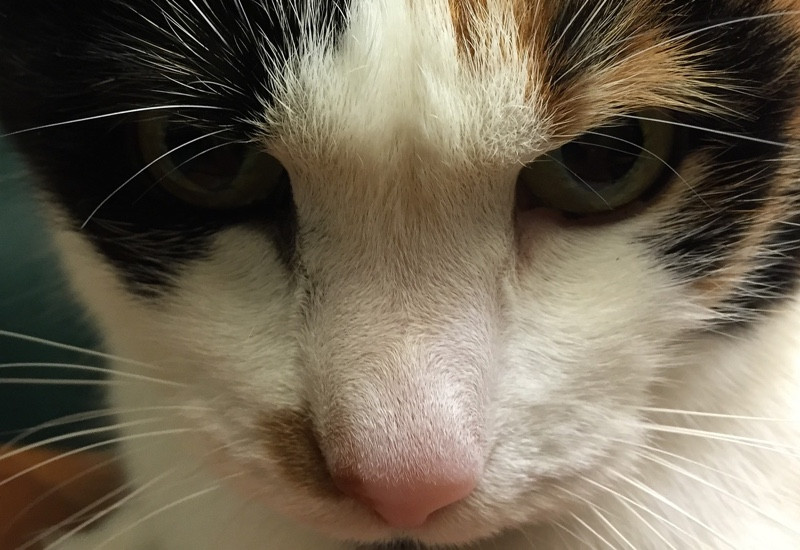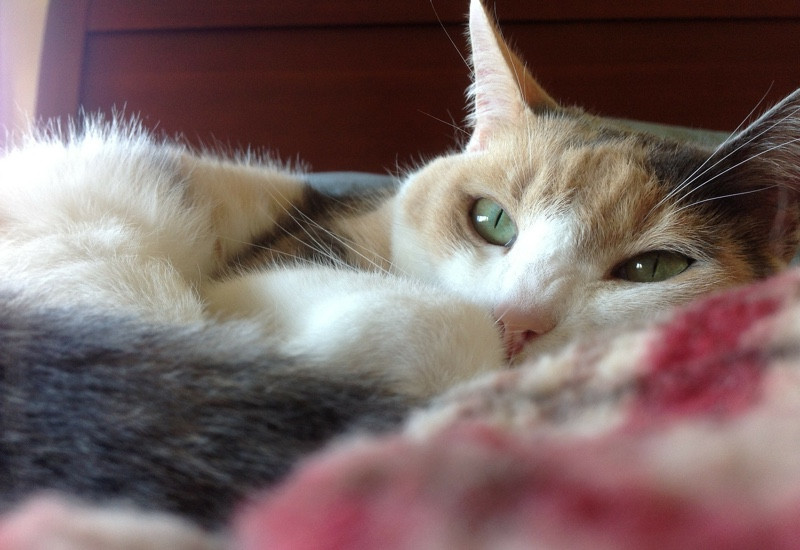Are you curious about the captivating beauty and unique genetics of Calico cats? Calico cats, with their distinctive tri-color coats, are almost exclusively female, a fascinating quirk of genetics that makes them all the more special. At solcat.net, we delve into the science behind this phenomenon, exploring the X chromosome’s role in determining coat color and the rare exceptions that prove the rule.
If you’re a cat lover, a proud owner, or simply intrigued by these stunning felines, join us at solcat.net to discover everything you need to know about Calico cats, from their origins and personalities to their care and genetics. With interesting articles and a community of feline enthusiasts, we provide a wealth of knowledge. Explore the allure of Calico cats and enrich your understanding of these unique creatures.
1. What Exactly Is A Calico Cat?
A Calico cat isn’t a specific breed but rather a cat with a particular coat color pattern. Unlike breeds such as Persians or American Shorthairs, “Calico” describes the tri-color coat consisting of white, orange, and black patches. Calico cats are distinguished by their unique fur coloring, which features a mix of colors like cream, reddish-brown, or blue-black, making each Calico cat unique.
To further elaborate on the calico cat’s appearance, the distribution of colors can vary greatly. Some calicos may have large, distinct patches of color, while others may have a more mottled or blended appearance. The white color typically makes up a significant portion of the coat, with the other colors appearing as spots or patches against the white background. This vibrant combination of colors makes calico cats visually striking and beloved by cat enthusiasts.
Calico vs. Tortoiseshell Cats: What’s the Difference?
Calico cats are often confused with Tortoiseshell cats, but the key difference lies in the presence of white fur. Calicos typically have a predominantly white coat with distinct patches of orange and black, while Tortoiseshell cats exhibit a mottled or brindled mix of black and orange without the white patches.
The difference between Calico and Tortoiseshell cats can also be subtle variations in the shades and patterns of their fur. Tortoiseshell cats, often called “Torties,” display a blend of colors that can include chocolate, cream, and red, creating a marbled or patchwork effect. Calico cats, on the other hand, maintain the distinct white base with clearly defined patches of black and orange.
 A close-up of a calico cat's face, showcasing the distinct tri-color pattern of white, orange, and black. The cat's eyes are bright and alert.
A close-up of a calico cat's face, showcasing the distinct tri-color pattern of white, orange, and black. The cat's eyes are bright and alert.
2. Why Are Most Calico Cats Female?
The distinctive tri-color coat of Calico cats is primarily found in females due to the way genetics work with the X chromosome. Cats require two X chromosomes to display the Calico coloration. Female cats, with their XX chromosome pairing, can carry the genes for both orange and black fur, resulting in the distinctive tri-color pattern when combined with white. Male cats, possessing only one X chromosome (XY), typically cannot express both colors, making Calico males extremely rare.
In terms of genetic explanation, female cats have two X chromosomes (XX), one from each parent. One of these X chromosomes is randomly inactivated in each cell, a process called X-inactivation or Lyonization. If a cell inactivates an X chromosome carrying the gene for black fur, the cell will produce orange fur, and vice versa. This results in a mosaic pattern of orange and black fur, which, when combined with white spotting genes, creates the Calico pattern.
The Exception: Male Calico Cats And Klinefelter’s Syndrome
While rare, male Calico cats do exist, typically due to a genetic anomaly called Klinefelter’s Syndrome (XXY). This condition allows them to exhibit the tri-color coat, but it also leads to sterility and potential health issues. Male Calico cats are exceptional, making them a genetic oddity.
Klinefelter’s Syndrome in male calico cats occurs when a male cat inherits an extra X chromosome, resulting in an XXY chromosome configuration. This genetic anomaly disrupts the normal development of the cat, leading to a range of health issues. In addition to sterility, male calico cats with Klinefelter’s Syndrome may experience cognitive and developmental problems, reduced bone mineral content, and increased body fat, which can lead to conditions such as joint pain, heart disease, and diabetes.
3. Where Did Calico Cats Originate?
The exact origins of Calico cats are uncertain, but it is believed they first appeared in Egypt. From there, they may have spread along the Mediterranean, reaching port cities in Italy, Spain, and France. Today, Calico cats can be found worldwide, adding a touch of color to many homes.
Genetic studies have supported the Mediterranean region as a possible origin point for Calico cats. Research indicates that the genetic mutations responsible for the Calico coloration may have first emerged in this area and then spread through trade routes and human migration. This theory is consistent with historical records and accounts of cats traveling on ships, which would have facilitated their dispersal to different parts of the world.
Calico Cats Around The World
Today, Calico cats are popular in many countries and cultures. Each region has its own unique appreciation for these tri-colored felines.
| Region | Cultural Significance |
|---|---|
| Japan | Considered good luck; the basis for the Maneki-Neko (“beckoning cat”) figurines. |
| United States | The official state cat of Maryland, chosen for its colors resembling the Baltimore Oriole. |
| United Kingdom | Male Calico cats are seen as particularly lucky due to their rarity. |
| Ireland | Folklore suggests rubbing a Calico cat’s tail can cure warts. |
4. What’s A Calico Cat’s Personality Like?
Calico cats are not a specific breed; their personality is influenced by breed, genetics, and environment. However, anecdotal evidence suggests that Calico cats are often warm-hearted, loyal, spunky, and independent, adding to their unique charm.
Individual experiences and upbringing play a significant role in shaping a Calico cat’s personality. Cats that have been raised in loving, stimulating environments tend to be more sociable, playful, and confident. Early socialization with humans and other animals can also contribute to a well-adjusted and friendly temperament. Conversely, cats that have experienced trauma or neglect may be more reserved or fearful.
Understanding Calico Cat Behavior
Calico cats are known for their quirky traits and behaviors. Understanding these can help owners better connect with their feline companions.
- Independence: Calico cats often exhibit a strong sense of independence, enjoying their own company and exploring their surroundings on their own terms.
- Playfulness: Despite their independent nature, Calico cats can also be playful and enjoy interactive games with their owners, such as chasing toys or playing fetch.
- Curiosity: Calico cats are naturally curious creatures, always eager to investigate new sights, sounds, and smells.
- Vocal: Some Calico cats can be quite vocal, expressing their needs and desires through meows, purrs, and other vocalizations.
- Affectionate: While they may not always be overly cuddly, Calico cats can be affectionate and enjoy spending time with their owners, often showing their love through gentle headbutts, slow blinks, and soft purrs.
5. How Long Do Calico Cats Usually Live?
The Calico coloration itself does not affect a female cat’s lifespan. Most healthy female Calico cats can live around 15 years or more with proper care. However, male Calico cats with Klinefelter’s Syndrome may face health challenges that can shorten their lifespan.
Various factors influence the longevity of Calico cats, including genetics, diet, lifestyle, and access to quality veterinary care. Cats with a healthy genetic background and a well-balanced diet are more likely to live longer, healthier lives. Regular exercise, mental stimulation, and preventive care, such as vaccinations and parasite control, also play a crucial role in promoting longevity.
Health Issues In Male Calico Cats
Male Calico cats are prone to Klinefelter’s Syndrome, which can lead to several health problems.
- Cognitive and developmental issues: These can lead to behavioral problems and reduced quality of life.
- Reduced bone mineral content: This increases the risk of fractures and bone-related issues.
- Increased body fat: This can result in joint pain, heart disease, and diabetes.
It’s essential to provide special care and monitoring for male Calico cats to manage these potential health issues effectively. Regular veterinary check-ups, a balanced diet, and a comfortable living environment can significantly improve their quality of life and overall well-being.
6. How Do I Care For A Calico Cat?
Caring for a female Calico cat is similar to caring for any other cat. Regular grooming, a balanced diet, and annual vet check-ups are crucial. Consider cat insurance to help manage potential healthcare costs and ensure your feline friend receives the best care possible.
Preventive care is also essential to maintain the health and well-being of Calico cats. Regular vaccinations, parasite control, and dental care can help prevent common feline illnesses and diseases. It is also important to provide a safe and stimulating environment for your cat, with plenty of opportunities for exercise, play, and mental enrichment.
Essential Care Tips For Calico Cats
- Regular Brushing: Keep their coat in great shape by brushing regularly.
- Annual Vet Check-Ups: Ensure they receive routine preventive care and vaccinations.
- Balanced Diet: Provide a high-quality diet suited to their age and activity level.
- Mental Stimulation: Offer toys and activities to keep them mentally stimulated.
- Love and Attention: Spend quality time with your Calico cat to strengthen your bond.
 A playful calico cat is mid-leap, showcasing its tri-color coat in motion. The cat's expression is one of joyful energy.
A playful calico cat is mid-leap, showcasing its tri-color coat in motion. The cat's expression is one of joyful energy.
7. Fun Calico Cat Facts
Calico cats have many fascinating associations and cultural significances around the world, making them more than just pretty faces.
Calico Cat Trivia
- Official Cat: Calico cats are the official cat of Maryland due to their colors resembling the Baltimore Oriole.
- Good Luck Charms: In Japan, Calico cats are considered lucky and were often taken on ships for protection.
- Beckoning Cats: The famous Maneki-Neko figurine is based on a Calico cat, symbolizing good fortune.
- Money Cats: In the U.S., they were once called “Money Cats” due to the belief they would fetch high prices.
- Wart Cures: Irish folklore suggests rubbing a Calico cat’s tail can cure warts.
8. Names For Calico Cats
Choosing a name for your Calico cat can be inspired by their unique coloring, personality, or historical significance. Here are some popular names:
Popular Calico Cat Names
| Name | Inspiration |
|---|---|
| Amber | Reflects their fall colors |
| Patches | Highlights their fur patterns |
| Lucky | Reflects their good luck association |
| Sassy | Suits their spunky personality |
| Cleopatra | Links to their possible Egyptian origins |
| Bella | Simple, cute, and easy to pronounce |
| Harmony | The combination of colors brings harmony |
Creative Calico Cat Names
| Name | Inspiration |
|---|---|
| Amaretto | Inspired by the almond-flavored liqueur |
| Confetti | Reflects the mix of colors |
| Oriole | Honors Maryland’s state bird |
| Picasso | Celebrates the artistic blend of colors |
| Sunflower | Evokes the warm, bright colors |
These names, along with many others, can help you find the perfect moniker for your new Calico companion, celebrating their unique beauty and personality.
9. Where Can I Find More Information About Calico Cats?
For more in-depth information about Calico cats, solcat.net is an excellent resource. Our website features articles, guides, and community forums where you can learn about Calico cat care, genetics, and behavior. You can also find tips on how to choose the right food, toys, and accessories for your feline friend.
To enhance your knowledge about Calico cats, consider exploring these resources:
- Cornell Feline Health Center: Offers comprehensive information on feline health and genetics.
- American Animal Hospital Association (AAHA): Provides valuable insights into pet care and veterinary practices.
- Cat Fanciers’ Association (CFA): Offers breed information and resources for cat enthusiasts.
These resources can help you stay informed about the latest research and best practices in feline care, ensuring you provide the best possible life for your Calico cat.
10. Why Choose Solcat.net For Your Cat Information Needs?
Solcat.net is your go-to destination for reliable, engaging, and up-to-date information about cats. Our website is dedicated to providing cat lovers with a wealth of resources to help them care for their feline companions. Whether you’re a seasoned cat owner or a first-time pet parent, you’ll find valuable information on our site to enhance your understanding of cats and improve their well-being.
At solcat.net, we understand that every cat is unique, which is why we strive to offer a wide range of content that caters to different breeds, personalities, and lifestyles. From articles on cat behavior and health to tips on grooming and nutrition, we cover all aspects of cat care to help you provide the best possible life for your furry friend.
Benefits Of Visiting Solcat.Net
- Reliable Information: Our content is based on expert knowledge and the latest research.
- Engaging Content: We offer a variety of articles, images, and videos to keep you entertained and informed.
- Community Forums: Connect with other cat lovers and share your experiences and insights.
- Up-To-Date Resources: Stay informed about the latest products, services, and events in the cat world.
- Comprehensive Guides: Find detailed information on all aspects of cat care, from health to behavior.
If you’re passionate about cats and want to stay informed about the latest trends and developments in the feline world, solcat.net is the perfect online destination for you. Join our community of cat lovers today and unlock a wealth of knowledge to help you become the best possible cat parent.
We invite you to explore solcat.net and discover a world of information tailored for cat enthusiasts. From understanding the unique genetics of Calico cats to finding the perfect name for your new feline friend, our website offers a wealth of resources to enhance your knowledge and appreciation of these wonderful animals. Visit solcat.net today and connect with a community of cat lovers who share your passion.
Ready to dive deeper into the fascinating world of cats? Visit solcat.net now to explore our articles, connect with fellow cat lovers, and discover everything you need to know about these amazing animals!
Address: 950 Alaskan Way, Seattle, WA 98104, United States.
Phone: +1 (206) 386-4000.
Website: solcat.net.
Frequently Asked Questions (FAQ) About Calico Cats
1. Why are Calico cats so special?
Calico cats are special because of their unique tri-color coat and the genetic rarity of male Calico cats, making them highly prized.
2. Are Calico cats hypoallergenic?
No, Calico cats are not hypoallergenic. Allergies are typically triggered by proteins in a cat’s saliva and skin, not their coat color.
3. What is the average cost of a Calico cat?
The cost of a Calico cat can vary widely depending on breed and location, but they are often adopted from shelters for a nominal fee.
4. Do Calico cats require special food?
Calico cats do not require special food, but a high-quality diet appropriate for their age and activity level is essential for their health.
5. How can I tell if my Calico cat is happy?
Signs of a happy Calico cat include purring, kneading, relaxed body posture, and regular grooming habits.
6. Are Calico cats good with children?
Calico cats can be good with children, especially if they have been raised together and the children are taught to treat the cat gently and respectfully.
7. What are common health issues for Calico cats?
Common health issues for female Calico cats are similar to those of other cats, while male Calico cats may be prone to Klinefelter’s Syndrome.
8. How often should I groom my Calico cat?
You should groom your Calico cat regularly, ideally a few times a week, to keep their coat healthy and reduce shedding.
9. Can Calico cats be trained?
Yes, Calico cats can be trained using positive reinforcement techniques, such as treats and praise.
10. What is the best way to adopt a Calico cat?
The best way to adopt a Calico cat is to check local animal shelters and rescue organizations, as they often have Calico cats available for adoption.

